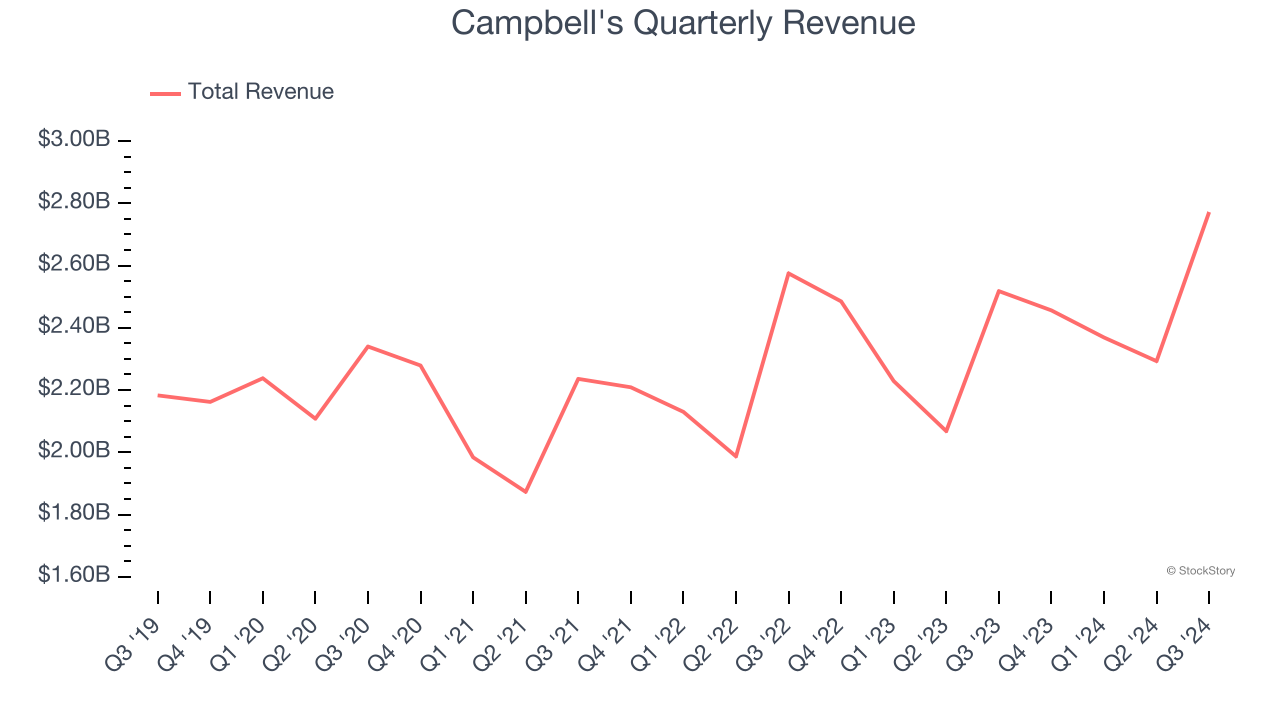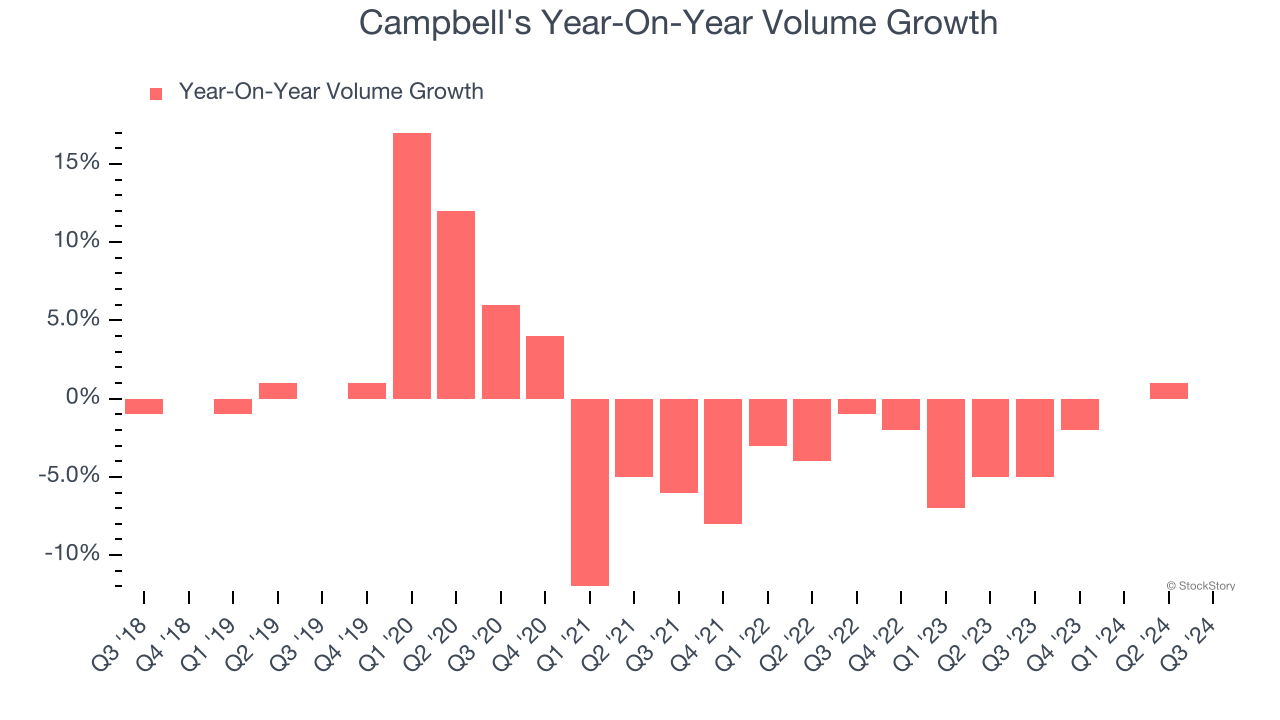Packaged food company Campbell's (NASDAQ:CPB) missed Wall Street’s revenue expectations in Q3 CY2024, but sales rose 10.1% year on year to $2.77 billion. Its non-GAAP profit of $0.89 per share was 1.6% above analysts’ consensus estimates.
Is now the time to buy Campbell's? Find out by accessing our full research report, it’s free.
Campbell's (CPB) Q3 CY2024 Highlights:
- Revenue: $2.77 billion vs analyst estimates of $2.80 billion (10.1% year-on-year growth, 1.1% miss)
- Adjusted EPS: $0.89 vs analyst estimates of $0.87 (1.6% beat)
- Adjusted EBITDA: $541 million vs analyst estimates of $540 million (19.5% margin, in line)
- Management reiterated its full-year Adjusted EPS guidance of $3.17 at the midpoint
- Operating Margin: 13.2%, in line with the same quarter last year
- Free Cash Flow Margin: 4.1%, up from 1.2% in the same quarter last year
- Organic Revenue fell 1% year on year, in line with the same quarter last year
- Sales Volumes were flat year on year (-5% in the same quarter last year)
- Market Capitalization: $12.07 billion
Company Overview
With its iconic canned soup as its cornerstone product, Campbell's (NASDAQ:CPB) is a packaged food company with an illustrious portfolio of brands.
Shelf-Stable Food
As America industrialized and moved away from an agricultural economy, people faced more demands on their time. Packaged foods emerged as a solution offering convenience to the evolving American family, whether it be canned goods or snacks. Today, Americans seek brands that are high in quality, reliable, and reasonably priced. Furthermore, there's a growing emphasis on health-conscious and sustainable food options. Packaged food stocks are considered resilient investments. People always need to eat, so these companies can enjoy consistent demand as long as they stay on top of changing consumer preferences. The industry spans from multinational corporations to smaller specialized firms and is subject to food safety and labeling regulations.
Sales Growth
A company’s long-term sales performance can indicate its overall quality. Any business can put up a good quarter or two, but many enduring ones grow for years.
Campbell's is one of the larger consumer staples companies and benefits from a well-known brand that influences consumer purchasing decisions. However, its scale is a double-edged sword because there are only a finite number of major retail partners, placing a ceiling on its growth. To accelerate sales, Campbell's must lean into newer products.
As you can see below, Campbell's grew its sales at a mediocre 5.7% compounded annual growth rate over the last three years as consumers bought less of its products. We’ll explore what this means in the "Volume Growth" section.

This quarter, Campbell’s revenue grew by 10.1% year on year to $2.77 billion but fell short of Wall Street’s estimates.
Looking ahead, sell-side analysts expect revenue to grow 6.9% over the next 12 months, similar to its three-year rate. This projection is above the sector average and suggests its newer products will catalyze better top-line performance.
Here at StockStory, we certainly understand the potential of thematic investing. Diverse winners from Microsoft (MSFT) to Alphabet (GOOG), Coca-Cola (KO) to Monster Beverage (MNST) could all have been identified as promising growth stories with a megatrend driving the growth. So, in that spirit, we’ve identified a relatively under-the-radar profitable growth stock benefiting from the rise of AI, available to you FREE via this link.
Volume Growth
Revenue growth can be broken down into changes in price and volume (the number of units sold). While both are important, volume is the lifeblood of a successful staples business as there’s a ceiling to what consumers will pay for everyday goods; they can always trade down to non-branded products if the branded versions are too expensive.
To analyze whether Campbell's generated its growth from changes in price or volume, we can compare its volume growth to its organic revenue growth, which excludes non-fundamental impacts on company financials like mergers and currency fluctuations.
Over the last two years, Campbell’s average quarterly sales volumes have shrunk by 2.5%. This decrease isn’t ideal as the quantity demanded for consumer staples products is typically stable. Luckily, Campbell's was able to offset fewer customers purchasing its products by charging higher prices, enabling it to generate 2.4% average organic revenue growth. We hope the company can grow its volumes soon, however, as consistent price increases (on top of inflation) aren’t sustainable over the long term unless the business is really really special.

In Campbell’s Q3 2025, year on year sales volumes were flat. This result was a well-appreciated turnaround from its historical levels, showing the company is heading in the right direction.
Key Takeaways from Campbell’s Q3 Results
Revenue missed while EPS beat. Overall, this was a mixed quarter. That management reiterated full-year EPS guidance is comforting, showing that there are no major changes to previously-observed trends in demand and expenses.
Is Campbell's an attractive investment opportunity right now? If you’re making that decision, you should consider the bigger picture of valuation, business qualities, as well as the latest earnings. We cover that in our actionable full research report which you can read here, it’s free.
